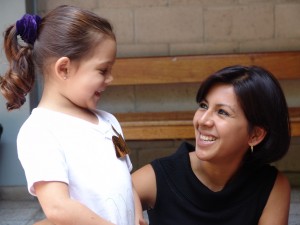RISK FACTORS AND PROTECTIVE FACTORS FOR CHILDREN
With 1 in 8 children and young people between the age of 5 and 16 suffering from a clinically diagnosable mental health issue (Mental Health of Children and Young People Survey, 2018) and with these figures on the rise, school staff are in a unique position to help address the problem by supporting the children in their care. School is the only environment that staff can control for children and young people. It is, therefore, vital that school staff do what they can to provide stability within the school setting to increase Protective Factors and ensure pupils are best equipped to handle the adverse conditions they may be faced with outside school.
A Risk Factor can be defined as “a characteristic at the biological, psychological, family, community, or cultural level that is associated with a higher likelihood of problem outcomes.” (O’Connell, Boat, & Warner, 2009). Risk Factors are things like: poverty, domestic violence, neglect, attachment issues. It is highly likely that there has been an increase in Risk Factors as a result of lockdown, during the Covid Pandemic (NSPCC Learning, 2020), making this issue all the more pertinent today. Contrastingly, a Protective Factor is an aspect of “individual or environmental characteristics, conditions, or behaviours that reduce the effects of stressful life events; increase an individual’s ability to avoid risks or hazards; and promote social and emotional competence to thrive in all aspects of life now and in the future.” (Kipke,1999). Protective Factors are things like: being able to self-regulate emotions, having a significant adult, having good self-esteem; all of which contribute to resilience in the face of adversity. Given this, then the school environment and its relationships, including pupil-teacher, have a role to play in developing children and young people’s resilience. In order that a child is able to thrive and not just survive, any Risk Factors need to be balanced with Protective Factors.
When the main Risk Factor in a pupil’s life is an attachment issue or ‘lack of Significant Adult’, it’s possible that an adult at school could become their ‘Significant’ Adult. If a good relationship and connection is built, not only can the staff member become the attachment figure for the pupil, but, in so doing, they can also help to increase the pupil’s self-esteem and self-worth.
SCHOOL STAFF AS SIGNIFICANT ADULT
Some of the problems associated with attachment issues (see our blog on Understanding Attachment and Developmental Trauma) can be counteracted with much care, attention and appropriate responses from another adult with whom the child may be in contact on a regular basis. This could be a foster carer, social worker, adoptive parent, or one of their teachers (Murphey, et al 2013).
A particularly positive relationship between an adult and a child, where it can be seen to have a beneficial effect on the emotional, mental, academic and/or social growth of the young person can be called a ‘developmental relationship’ (Li & Julian, 2012).
PROTECTIVE FACTOR OF TEACHER-PUPIL RELATIONSHIPS
Bergin, C., & Bergin, D. (2009) investigated and presented the importance of every student having at least one significant adult with whom they have a caring relationship. They report on studies by Hamre and Pianta (2001), where it has been shown that particular pupils (those typically with more Rik Factors outside of school) who had not formed a good relationship with their primary school teachers, found it more difficult to form a relationship with their secondary school teachers, as well as developing more behavioural problems when moving on to secondary school. The primary school teachers reported that it was especially difficult to form a bond with certain pupils, who, upon investigation, were revealed to have insecure or disorganised attachment at home. It is even more important to invest the time to develop good relationships with these pupils. As Nicholas Ferroni insightfully states, “Students who are loved at home, come to school to learn, and students who aren’t, come to school to be loved.”

A child needs someone who knows them well, knows their strengths, respects them, can ‘check in’ with them regularly and act as an advocate, if necessary. Given that a teacher also, traditionally, has a role of authority, as well as nurturing (VanderStaay et al. 2009) it would appear natural for some sort of attachment to occur, as they are also a source of security and safety, both of which are fundamental to the initial principles of attachment. If the relationship between teacher and pupil is also a positive and caring one, a strong, attachment-like relationship can form. This relationship can go some way towards filling the void in the pupil’s life where an attachment relationship was absent, and, in turn, help to build the emotional development of the child that may otherwise be stinted.
Having a positive relationship with the teacher, built on trust and mutual respect, also serves to challenge the pupil’s Unhealthy Inner Working Model (the way they view the world and themselves), enabling them to see that the world may not be such a hostile place after all, that adults are trustworthy and can be counted on and that they themselves are, indeed, worthy. This can then have an impact on their other relationships, now and in the future.
In addition to boosting their self-esteem and sense of self-worth, feeling the support of the teacher can also boost the pupils’ motivation to learn. The motivation to do well can be because of a desire to please the teacher, prove to the teacher that they are capable of succeeding and to show the teacher that the effort they put into planning and giving lessons was indeed effective. They will feel encouraged to succeed both for themselves and for the teacher (Fry & Coe 1980). Additionally, if the pupil likes the teacher and feels that the teacher likes them in return, they will be less likely to misbehave and act disruptively during classes, and therefore less likely to sabotage their own learning and the learning of others around them.
IMPLEMENTING THESE FINDINGS INTO TEACHING PRACTICE
 There are many positive and effective ways that teachers can develop positive relationships with pupils and increase the possibility of becoming a Significant Adult in a pupil’s life. First and foremost by showing the child that they care about and are interested in them. This can be done in a variety of ways, starting out with a simple, personalised greeting whenever they see them. In their first lesson, the teacher can get pupils to fill in questionnaires about their interests, hobbies and hopes, and then use this information in future lessons, as well as in interactions with the pupil. Including personal information in lessons, not only makes the lessons more personal and relevant to the pupils, but also shows them that the teacher has been paying attention to them and has made an effort to make them feel included and represented. This gives them a sense of importance and worthiness. Having fun with pupils also helps to break down barriers and build relationships.
There are many positive and effective ways that teachers can develop positive relationships with pupils and increase the possibility of becoming a Significant Adult in a pupil’s life. First and foremost by showing the child that they care about and are interested in them. This can be done in a variety of ways, starting out with a simple, personalised greeting whenever they see them. In their first lesson, the teacher can get pupils to fill in questionnaires about their interests, hobbies and hopes, and then use this information in future lessons, as well as in interactions with the pupil. Including personal information in lessons, not only makes the lessons more personal and relevant to the pupils, but also shows them that the teacher has been paying attention to them and has made an effort to make them feel included and represented. This gives them a sense of importance and worthiness. Having fun with pupils also helps to break down barriers and build relationships.
Small gestures can show the pupil you care and will be there for them. This is particularly important where young people have significant attachment issues and have not been able to count on adults to meet their needs. One way to do this is by swapping pens while they complete a task during the lesson, or at the end of the day and saying to them that in the next lesson, or the next day, you will swap back. This lets the pupil know that you will be there for them later, or the next day, as and when expected; that you are consistent in their life. It also shows the pupil that you will keep your word and that you are reliable; again challenging their unhealthy IWM. Showing that you have been thinking about the pupil, even when they are not there, is a very effective way of establishing a positive relationship with them. It lets the pupil know that they have been ‘kept in mind’, something that has been lacking for children with insecure attachments (Mikulincer, Shaver, & Pereg 2003). For example, if they support a certain sports team, mentioning that you thought about the pupil at the weekend as you saw their team playing, will have a huge effect on their self-esteem and need for attention, as well as helping to build an attachment-like relationship (Bombèr 2011).
Schools should become ‘attachment aware’ so that they understand that the difficulties pupils are experiencing may manifest as behaviour issues. For example, pupils who demonstrate disruptive and ‘attention seeking’ behaviour, could actually be ‘attention needing’. It’s important that teachers understand this and know how to deal with the behaviour in a more appropriate way, rather than punishing, which only serves to create more problems by reinforcing the Unhealthy IWM. Children may need ‘time in’, rather than ‘time out’, bringing them closer, rather than pushing them away or excluding them.
There is an excellent Ted Talk – Every Child Deserves a Champion, by Rita Pierson – that is well worth watching. Rita kept peanut butter and crackers in her desk drawer because she had students who she knew would not have eaten a proper breakfast. Whilst it’s obvious that being hungry can be detrimental to learning because of a lack of energy and the inability to concentate, the reasons for missing breakfast, which could be an unstable home-life, lack of food in the house, or lack of significant adult, are also significant Risk Factors. Rita’s gesture not only provided essential sustenance for the day of learning ahead, but also showed kindness and concern to those pupils who needed it.
Mealtimes are often an important time for talking, sharing and relationship-building and this can be emulated within the school. Secondary school teachers seldom eat lunch with their pupils in the canteen, yet this would be an ideal opportunity to build the teacher-pupil relationship. This casual period, outside of lesson time, provides an opportunity to talk about life beyond school, taking the teacher-pupil relationship outside the classroom and showing the child that they are important to their teacher on a personal, as well as academic level. This type of relationship enables the child to grow emotionally and socially.
The U.S. Department of Health and Human Services (2014) explored ways in which the theories of attachment and pupil-teacher relationships can be applied to teaching practice and implemented in schools. Some of their suggestions included the school involving pupils in crucial decision-making, such as in the creation of School Policies, in order to make them feel important and valued. Giving them a voice shows them that the school staff not only care about their learning but also about them as an individual and that they respect their opinion. Another way could be structuring the school so that the pupils have the same teacher for the same subject, wherever feasible, throughout their school career as they move up through the school, in order to keep as much consistency in their lives as possible.

As mentioned, coping mechanisms, developed due to insecure attachment, often manifest themselves as behaviour issues in school. These are frequently misinterpreted and subsequently dealt with by teachers in the wrong way, for example by punishing the child with detention or exclusion and further exacerbating the situation. Being excluded from school isolates the child further, rather than encouraging them to talk about how they feel and to find out more about why they may have acted the way they did, thus further reducing their chances of forming positive relationships. Using a Restorative Approach to behaviour management, not only enables the pupil to see and understand the consequences their actions have on other people, have their voice heard and feel valued, but also helps them to recognise the thoughts and feelings that might be driving their behaviour, which, in turn helps them to learn how to self-regulate (which, remember, is also a Protective Factor. This exculpatory approach to behaviour management also provides another platform on which to build trust and respect between the teacher and all the pupils involved, thus strengthening relationships.
As demonstrated, having a Significant Adult is crucial in the development of a child’s socio-emotional well-being, which in turn is the foundation for academic success, as well as for their happiness and success in life beyond school. It must, therefore, be a high priority for all teachers everywhere.

Leave Your Reply Cancel reply
You must be logged in to post a comment.



